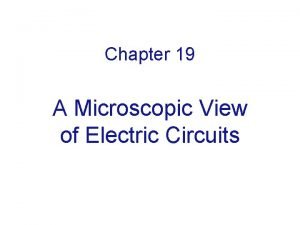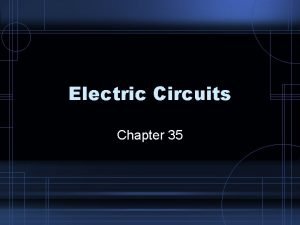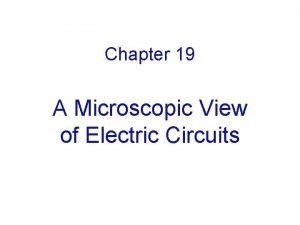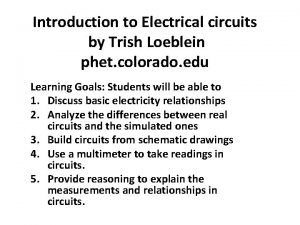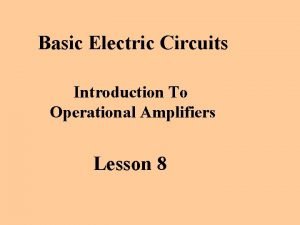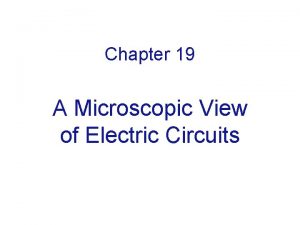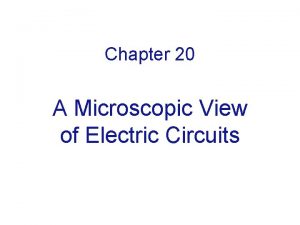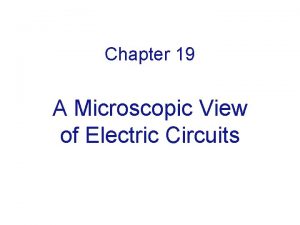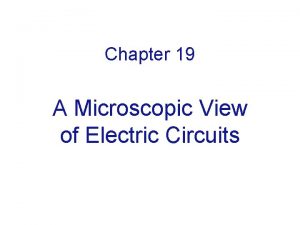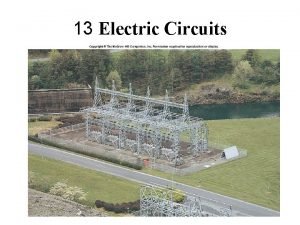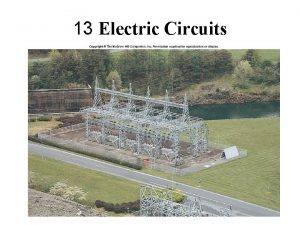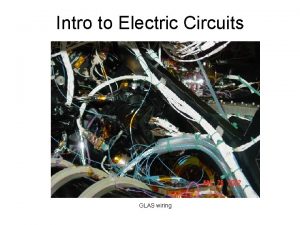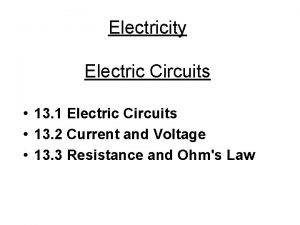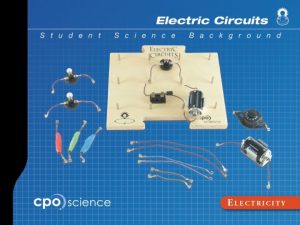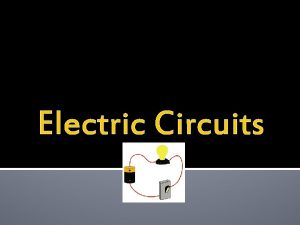Chapter 19 A Microscopic View of Electric Circuits


















- Slides: 18

Chapter 19 A Microscopic View of Electric Circuits

Analysis of Circuits The current node rule (Charge conservation) Kirchhoff node or junction rule [1 st law]: In the steady state, the electron current entering a node in a circuit is equal to the electron current leaving that node Conventional current: I = |q|n. Au. E The loop rule (Energy conservation) Kirchhoff loop rule [2 nd law]: V 1 + V 2 + V 3 + … = 0 along any closed path in a circuit V= U/q energy per unit charge

Clicker A B Lamps are identical Batteries are identical In B batteries are connected in series Lamp is brighter in A) A B) B C) Lamps in A and B have the same brightness

Two Batteries in Series Why light bulb is brighter with two batteries? Two batteries in series can drive more current: Potential difference across two batteries in series is 2 emf doubles electric field everywhere in the circuit doubles drift speed doubles current. Work per second: e V=e. EL loss of electric potential energy (per sec will be power)

Energy in a Circuit Vwire = EL Vbattery = ? Energy conservation (the Kirchhoff loop rule [2 nd law]): V 1 + V 2 + V 3 + … = 0 along any closed path in a circuit V= U/q energy per unit charge

Question: Twice the Length 1 2 i 1 i 2 Nichrome wire (resistive) A) i 1 = i 2 B) i 1 = 2*i 2 C) i 1 = ½ i 2

Two Identical Light Bulbs in Series Two identical light bulbs in series are the same as one light bulb with twice as long a filament. Identical light bulbs Electron mobility in metals decreases as temperature increases! Conversely, electron mobility in metals increases as temperature decreases. Thus, the current in the 2 -bulb circuit is slightly more than that in the ½ of one-bulb circuit.

Question: Two Light Bulbs In series Parallel Identical light bulbs are first connected in series then parallel Will there be a difference in light brightness? A) There will be no difference B) In series connection will give brighter light C) Parallel connection will give brighter light

Two Light Bulbs in Parallel L … length of bulb filament 1. Path ABDFA: 2. Path ACDFA: 3. Path ABDCA: F i. B = i C ibatt = 2 i. B We can think of the two bulbs in parallel as equivalent to increasing the cross-sectional area of one of the bulb filaments.

Doubling the Cross-Sectional Area Loop: emf - EL = 0 Electron current in the wire increases by a factor of two if the crosssectional area of the wire doubles. Nichrome wire

Long and Round Bulb in Series only round bulb: The round bulb doesn’t light up!

How Do the Currents Know How to Divide?

Chapter 20 Capacitors, Resistors and Batteries

Electric Field of a Capacitor From lecture 7: Inside: Enet E+ E- Fringe: s 0 z

Capacitor: Construction and Symbols The capacitor in your set is similar to a large two-disk capacitor s There is no connecting path through a capacitor D

How is Discharging Possible? Positive and negative charges are attracted to each other: how can they leave the plates? Fringe field is not zero! Electrons in the wire near the negative plate feel a force that moves them away from the negative plate. Electrons near the positive plate are attracted towards it.

Capacitor: Discharge The fringe field of the capacitor plus the electric field of the charges on the surface of the wires drive current in a way to REDUCE the charge of the capacitor plates.

Capacitor: Charging t=0. 1 sec t=1 sec Why does current ultimately stop flowing in the circuit? Equilibrium Ultimately, the fringe field of the capacitor and the field due to charges on the wire are such that E=0 inside the wire. At this point, i=0.
 Is a light bulb an ohmic resistor
Is a light bulb an ohmic resistor Fundamentals of electric circuits chapter 4 solutions
Fundamentals of electric circuits chapter 4 solutions Chapter 20 electric circuits
Chapter 20 electric circuits Chapter 35 electric circuits
Chapter 35 electric circuits Chapter 20 electric circuits
Chapter 20 electric circuits 9
9 Fundamentals of electric circuits chapter 7 solutions
Fundamentals of electric circuits chapter 7 solutions Chapter 35 electric circuits answers
Chapter 35 electric circuits answers Worksheet circuits and ohm's law answer key
Worksheet circuits and ohm's law answer key Chapter 35 electric circuits
Chapter 35 electric circuits Microscopic view of current
Microscopic view of current Laplace pressure
Laplace pressure Advantages of parallel circuit over series circuit
Advantages of parallel circuit over series circuit Chapter 21 electric charge and electric field
Chapter 21 electric charge and electric field Chapter 21 electric charge and electric field
Chapter 21 electric charge and electric field Units for coulombs
Units for coulombs Dc o/d per item charge
Dc o/d per item charge Phet electric circuits
Phet electric circuits Electric circuits equations
Electric circuits equations
